Pisa - Following the path of Galileo
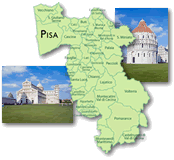
Few of the millions of visitors who cross Pisa’s Piazza del Duomo each year know that Galileo used this theatrical setting as a real scientific laboratory. It was inside the Cathedral that he calculated the law of the isochronism of pendulums by observing the oscillation of a votive lamp, and according to an unverifiable legend it was from the Cathedral’s bell-tower that he did his experiments on falling bodies. But Galileo’s life, like any Pisan’s of that era, was closely tied to these monuments. Galileo was baptized in the Baptistry, and the nearby cemetery, aside from being the burial place of great scientists, houses another important Galileo memento, the afore-mentioned votive lamp.
[Given the limitations on traffic in the historical centre , we advise you undertake the proposed itinerary on foot]
The Cathedral, a distinguished monument of Romanesque architecture, is the ideal starting point for our Galilean trek.
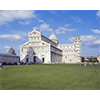
The construction of the cathedral of Pisa began in 1063 on a project by Buscheto. Consecrated in 1118, and restored following the tragic fire of 1595 and in the course of the 19th century, it houses masterpieces that make it one of the most famous and celebrated monuments: in addition to a rich sculptural decoration, worthy of note are the bronze door by Bonanno Pisano, the pulpit by Giovanni Pisano, Cimabue’s mosaic , and the pictorial cycle of the Tribune.
According to tradition, it was precisely inside the Cathedral around 1583 that, observing a lamp sway, the young Galileo Galilei was stimulated to undertake the road which was to lead him to discover the isochronism of pendulums. In his Racconto istorico della vita di Galileo (1654), loyal follower of Galileo, Vincenzo Viviani wrote: «Meanwhile, with the wisdom of his genius, he invented the very simple and regulated measuring of time by means of the pendulum, by no one observed till then, grasping the opportunity to observe it from the motion of a lamp, while he was one day in the Cathedral of Pisa».
Antonio Favaro demonstrated that the suspended lamp that still today is observed in the Cathedral was placed there after Galileo’s stay in Pisa. He therefore argued that the lamp referred to by Viviani had to be considered as a legend. More recently, however, it has been demonstrated that at the time of Galileo, there was another votive lamp suspended in the Cathedral, which is today found in the Monumental Cemetery of Pisa.
(Graziano Magrini)
In the Baptistry opposite, an intriguing complex built between the 12th and the 14th centuries, we can view documents attesting to Galileo’s baptism in 1564.
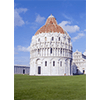
Begun on August 15, 1152 under the direction of Pisan architect Diotisalvi, this masterpiece of Romanesque architecture was enlarged on several occasions: in the course of the 13th century by Nicola and Giovanni Pisano, in the 14th century and, finally, in the 19th century when member of the Primaziale of Pisa, Vincenzo Carmignani, assisted by Pisan architect Alessandro Gherardesca, began a series of very contested restorations.
The Baptistery is also a "Galilean site": on February 19, 1564 Galileo was baptised here. The baptismal record can be read in the Libro del battesimo al Duomo, Lettera C (1564-1568), c. 36v, 221: «Galileo of Vincentio Ghalilei from Florence and Madame Giulia his wife was baptised on the 19th of the aforementioned day; sponsors and knights were Messrs. Pompeo and Haverardo de Medici, in the Chapel of Sant’Andrea».
(Alessandro Tosi)
In the Piazza del Duomo there is also the Monumental Cemetery, not only containing precious artworks but also the burial place of famous scientists such as the mathematician Leonardo Fibonacci and the physicist Carlo Matteucci.
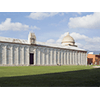
Built towards the end of the 13th century, the Cemetery of Pisa conserves an extraordinary patrimony of works of art, including famous pictorial testimonies and a prestigious collection of ancient sculpture. Until the 19th century, it also conserved a series of funerary monuments and busts of illustrious scientists and teachers of the Pisan Studio.
Among the funerary monuments, we cite in particular those of physician and man of letters Matteo Corte, writer Francesco Algarotti who distinguished himself in the dissemination of Newtonian physics, physicians Andrea Vaccà Berlinghieri and Giacomo Barzellotti, engineer Giuseppe Morosi from Ripafratta, physicist Lorenzo Pignotti, astronomer Ottaviano Fabrizio Mossotti, physicist Carlo Matteucci, chemist Giuseppe Orosi, mathematician Leonardo Fibonacci (later transferred to the Scotto Garden, and today once again relocated to the Cemetery), and natural scientist Paolo Savi (moved to the Botanical Garden of Pisa).
Among the busts, we cite those of botanist Gaetano Savi, mathematician and hydraulics engineer F.A. Puccinelli from Pescia, agronomist Pietro Cuppari, geologist Giuseppe Meneghini (moved to the premises of the Museum of Natural History of Calci).
The Cemetery is also tied to the name of Galileo Galilei. The Aulla Chapel conserves the votive lamp that was suspended in the Cathedral of Pisa in Galileo’s times when he perhaps conducted the observations on the isochronism of the pendulum, recounted by his follower Vincenzo Viviani in the Racconto Istorico della vita di Galileo (1654). The votive lamp today conserved in the Cemetery of Pisa is similar in style to the one depicted by Luigi Sabatelli in the fresco of the Tribune of Galileo, which portrays the Pisan scientist intent on observing the oscillations of a lamp in the Cathedral of Pisa.
(Alessandro Tosi)
Pisa’s bell-tower too is almost inevitably linked to Galileo. A Latin inscription over the entrance reminds us that here he conducted his experiments on falling bodies. Even if this tale may just be a legend that grew up over the centuries around the figure and work of Galileo, it has been historically proven that on more than one occasion the academicians of Cimento used the height of the bell-tower to prove their theories.
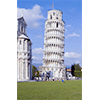
Begun in 1173, probably under the direction of Bonanno Pisano, the Bell Tower soon ran into problems around the subsidence of its foundations, indeed to the point of suspending worksite activity at length, which only resumed at the end of the following century under the direction of Giovanni di Simone. Of great interest are the seven bronze bells cast between the 15th and 18th century, the sound of which reproduce the notes on the musical scale.
The Tower of Pisa is often associated with the first experiments on the motion of weights, which Galileo Galilei is said to have conducted between 1590 and 1591 in the presence of students and teachers of the University of Pisa. The historical truthfulness of the fact, however, appears somewhat dubious, even though a Latin inscription at the entrance of the tower recalls that, from the peak of the Bell Tower, Galileo conducted his famous experiments on falling bodies. «And so, - writes his student Vincenzo Viviani in the Racconto istorico della vita di Galileo (1654) - with the great disconcertment of all philosophers, by means of experiments, sound demonstrations and discourses, Galileo convinced them of the falsity of many conclusions of Aristotle concerning the subject of motion, till then considered as very clear and indubitable; such as, among others, that the speed of moving objects of the same matter and of different weights, moving through the same medium, do not conserve the proportion of their gravity, assigned by Aristotle, but instead all move at the same speed, demonstrating this with repeated experiments performed from the top of the Bell Tower of Pisa in the presence of other lecturers and philosophers and of the entire student body».
The tower was also the site of an unsuccessful verification experiment conducted by Carlo Renaldini, a member of the Accademia del Cimento. He attempted several times «at the foot and at the top of the bell tower of Pisa», to verify the variation of the level of mercury according to altitude, but without succeeding «to obtain any fruit».
(Graziano Magrini)
Taking Via Santa Maria, you arrive at the Domus Galileiana, an institution founded in the 19th century to collect documents and manuscripts related to Galileo.
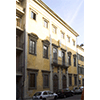
Instituted in 1941 with the purpose of collecting and preserving bibliographical and documentary sources on Galileo and his followers, the Domus Galilaeana conserves a rich library of some 40,000 titles, between volumes and pamphlets, and a precious nucleus of Galilean manuscripts and documents received on deposit from the University Library. For their value and uniqueness, we cite an autograph letter by Galileo Galilei to Fra’ Paolo Sarpi containing the first formulation of the law of falling bodies (1604), various iconographical materials concerning the Pisan scientist, the archive of the inventor of the dynamo Antonio Pacinotti, the papers of Antonio Favaro, curator of the monumental national edition of the works of Galileo (1890-1909), and the notes left by physicist Enrico Fermi at the time of his departure for the United States.
The Domus is headquartered in the rooms remaining of the old Observatory of the University of Pisa, the first public astronomical observatory of Tuscany and among the oldest in Italy, the construction of which began in 1734. It was situated in a five-storey tower that had been built over the remains of an older one on one side of the building. In 1739, a chair in astronomy was instituted at the University of Pisa and entrusted to Tommaso Perelli, who was also appointed director of the Pisan Observatory. Due to various difficulties, principally of a financial nature, the astronomical activity proper began only in 1846. As of 1765, Perelli could avail himself of the help of Giuseppe Antonio Slop de Cadenberg, who was later to take his place as director. Slop de Cadenberg began a regular observation activity and attended to the publication of six volumes of astronomical studies conducted in Pisa. Between the 18th and 19th centuries, Giuseppe Piazzini too, worked at the observatory, and successfully committed himself to renewing the instruments, though he was not successful in obtaining the longed-for creation of a new astronomical headquarters. In 1826, due to its precarious stability, the old astronomical tower was demolished. The Specola of Florence and the Ximenes Observatory thus remained the only astronomical centres active in Tuscany.
(Graziano Magrini)
Although you cannot visit inside, our itinerary is worth concluding with a brief detour to Casa Ammanati, where Galileo was born.
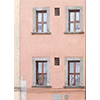
Many conjectures have been made as to the exact location of the house where Galileo Galilei was born. Following the indication in the baptismal record, which indicated the parish of Sant’Andrea as the scientist’s birthplace, until the mid 19th century it was believed that the house was found near the little church of the Fortress, that is to say, Sant’Andrea in Chinzica. This conviction was so well-rooted that in 1864, on the occasion of celebrations for the third centennial of the birth of Galileo, a plaque was placed on the wall of the Fortress which read: «Here was born Galileo Galilei on February 18, 1564». Several important details, however, were not taken into account, first and foremost the fact that to be born inside the Fortress, one had to be the child of a soldier, which was not the case of Galileo.
The mention of the parish of Sant’Andrea, however, also led scholars to discard yet another hypothesis according to which the scientist was born in a house that his father Vincenzo Galilei had rented from the Bocca family for one year, starting from August 1563. "Located in Chiasso dei Mercanti", this house still belonged to the parish of San Michele; this evident contradiction with the fact supplied by the baptismal record combines with the fact that, according to archive documents, Galileo’s father rescinded the contract several months prior to its natural expiration.
The most likely solution to this historical "enigma" resides in the mistaken identification of the church referred to by the baptismal record. The parish of Sant’Andrea was indeed not that of the Chinzica quarter, but rather the homonymous church of Sant’Andrea Foris Portam, under the jurisdiction of which, was the house of Galileo’s mother, Giulia Ammannati, since the early 16th century. Scholars therefore agree in recognising Ammannati House, still visible on Via Giusti, as the birthplace of the famous Pisan.
(Roberto Sonnini, Elena Fani)
****************************
Texts by Elena Fani
English translation by
Last update 09/ott/2008



 = libraries and archives
= libraries and archives  = scientific research centers
= scientific research centers  = memorial places of scientists
= memorial places of scientists = public health places
= public health places = places of science and worship
= places of science and worship = places of technology
= places of technology  = museums and collections
= museums and collections  = villas and gardens of science
= villas and gardens of science


